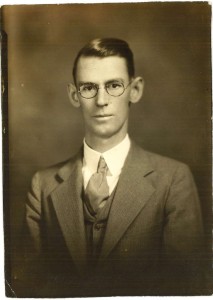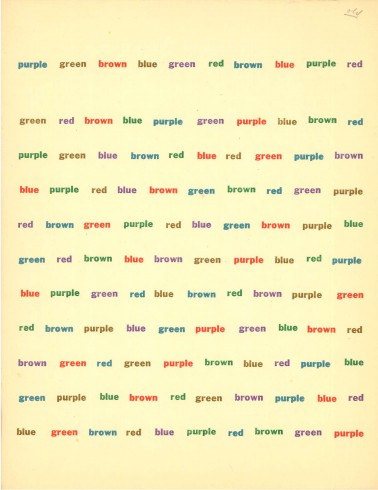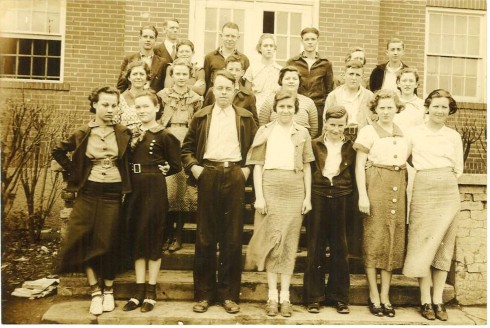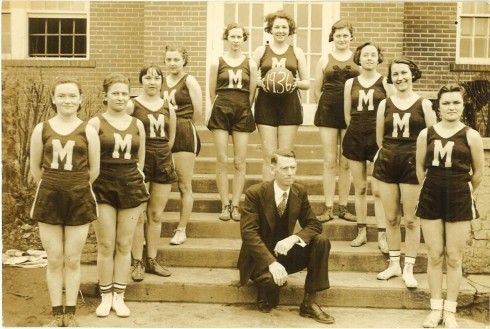J. Ridley Stroop: Beginnings and Research

Ca. 1932, when Stroop completed his PhD. Photograph, John Ridley Stroop Collection, Milliken Special Collections, Abilene Christian university, Abilene, TX
J. Ridley Stroop was born on 21 March 1897 in Murfreesboro, Tenn. He graduated first in his class from David Lipscomb College in 1921 and received a PhD in experimental psychology from George Peabody College in 1932. His dissertation, published in The American Journal of Experimental Psychology in 1935, focused on studies in interference and attention. This study developed into a test that has since become foundational for the field of cognitive psychology.
This test, most commonly known as the “Stroop Test,” or “Stroop Effect,” is a study of how interference affects brain processes. In the test, participants are given a set of color words – green, red, blue, etc. – printed in a different color ink than the one signified by the word given.

Stroop did not just use words to test his hypothesis; he also used shapes like these to see if the same interference appeared in both cases. Printed card, John Ridley Stroop Collection, Milliken Special Collections, Abilene Christian University, Abilene, TX.
Participants are first asked to read the words on the list, and their times are recorded. Then, testers ask the participants to read the list again, saying instead the name of the ink color the words are printed in, and these times are recorded. Most often, times for the second set are significantly slower. This illustrates that language processing in the brain is much stronger than color processing.
While this test has become foundational, it did not happen immediately. Initially, Stroop’s test received little attention; it was not until the 1960s that it began to influence the field of psychology. Now, it is included in many introductory texts, and it has been one of the most cited studies on cognition in the history of the The Journal of Experimental Psychology.1 Clearly, Dr. Stroop’s work was a success. So, it might come as a shock to some that, instead of continuing this work, he chose to dedicate his life to preaching, teaching, and studying the Bible.

A page from Stroop’s original materials for his experiments. Printed in 1932. Printed card, John Ridley Stroop Collection, Milliken Special Collections, Abilene Christian University, Abilene, TX.
J. Ridley Stroop: Scholar and Author

Dr. Stroop during his professorship at David Lipscomb College. Photograph, John Ridley Stroop Collection, Milliken Special Collections, Abilene Christian university, Abilene, TX
While many remember Dr. Stroop because of his work in psychology, his main corpus of work was in the study of the Bible. In this endeavor he was intimately connected with David Lipscomb College, having served as a faculty and staff member for about forty years. There, he served as librarian, registrar and professor, teaching English, Mathematics, Modern Languages, Psychology, and Bible. In 1968, he retired from DLC and became the dean of Ohio Valley College (now Ohio Valley University) in Parkersburg, West Virginia, for one year. He also traveled often as a preacher and published book related to his research in the Bible and the church. One of these books, God’s Plan and Me, is a three-volume work based off a class he taught at Lipscomb.
The collection includes many of his handwritten notes on the subjects of his books, and some of his personal financial records of his book sales.

Handwritten notes by Stroop on the Bible. Manuscript notes, John Ridley Stroop Collection, Milliken Special Collections, Abilene Christian University, Abilene, TX.

In 1936, Stroop worked as principal at Morrison High School. Here he is pictured with the freshman class. Photograph, John Ridley Stroop Collection, Milliken Special Collections, Abilene Christian University, Abilene, TX.

Stroop also coached the girls’ basketball team while at Morrison High. Photograph, John Ridley Stroop Collection, Milliken Special Collections, Abilene Christian University, Abilene, TX.
1MacLeod, C.M. (1992). “The Stroop Task: The ‘gold standard’ of attentional measures. Journal of Experimental Psychology, 121(1). 12-4.
